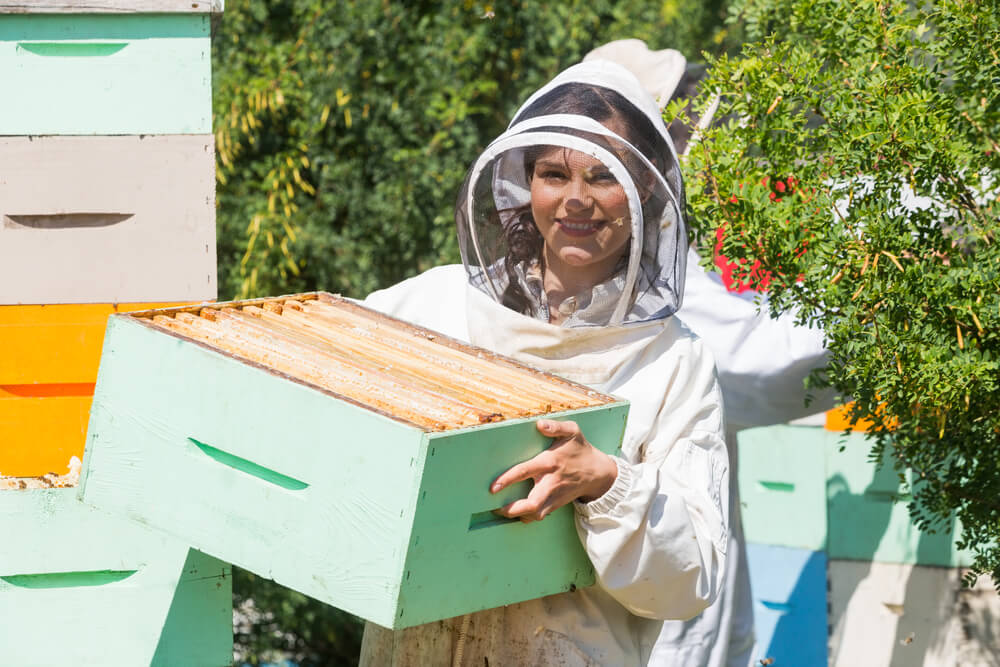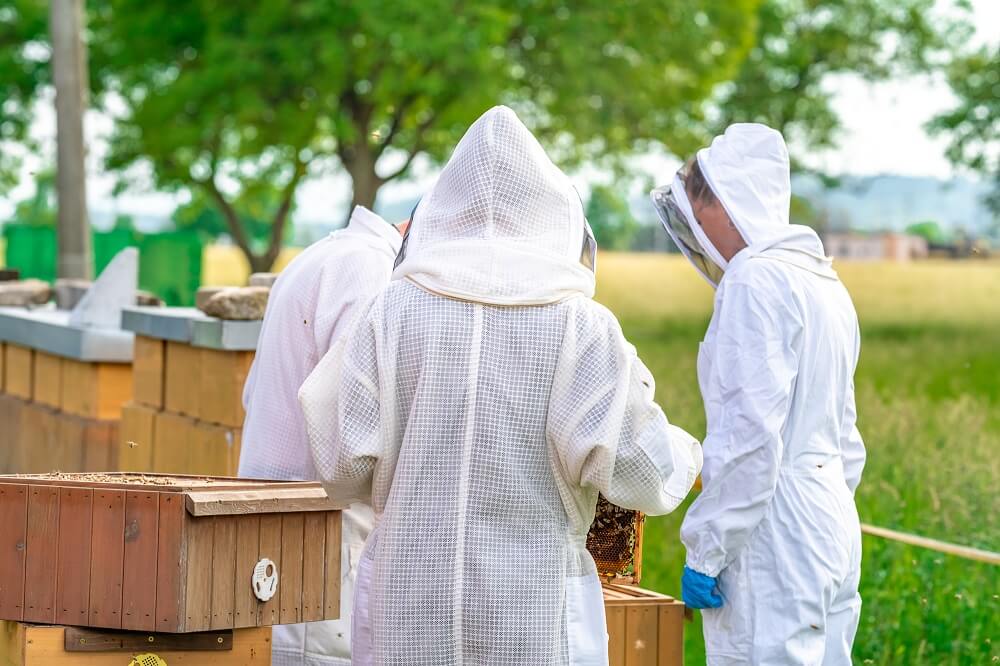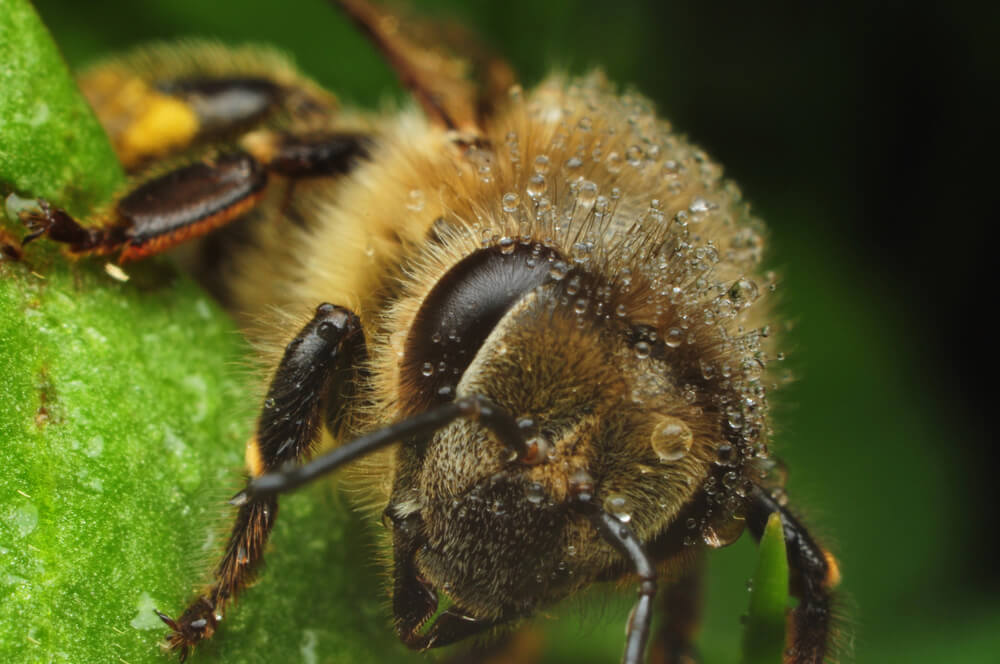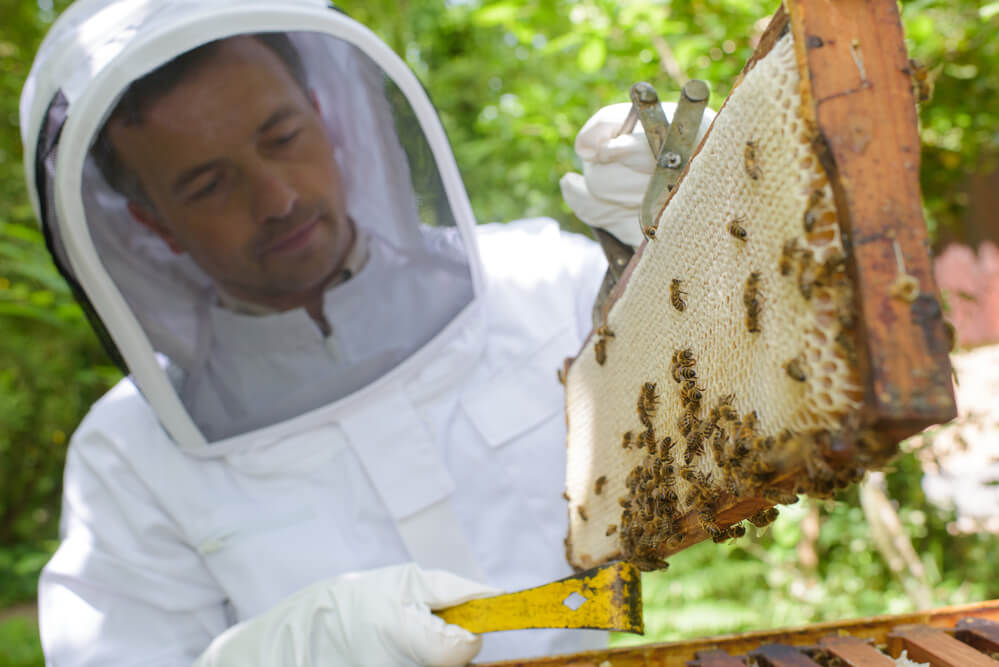Table of Contents:
What is a Super for Bees?
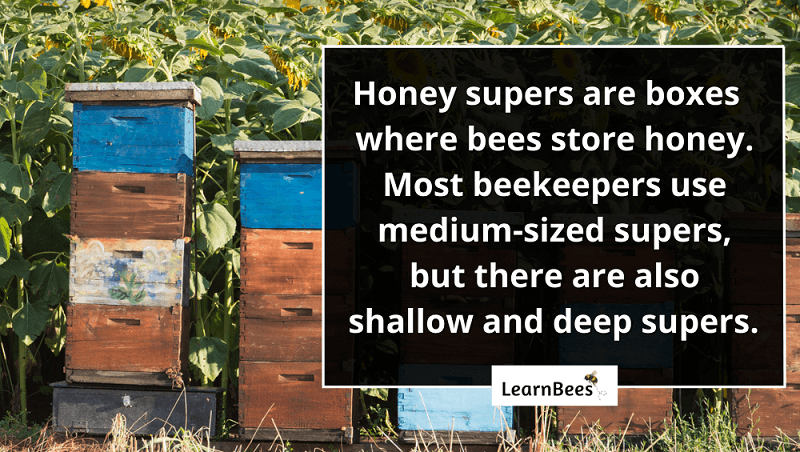
A honey super, or “super” for short, is a box placed on a honeybee hive for the bees to store honey. Supers go on top of the brood boxes.
Beekeepers often use a queen excluder between the honey super and brood box to stop the queen from laying eggs in the honeycomb.
There are three super sizes to choose from: shallow, medium, and deep.
More specifically, honey supers are measured in height:
- Deep (9-⅝ inches)
- Medium (6-⅝ inches)
- Shallow (5-¹¹⁄₁₆ inches)
The bigger the honey super, the heavier it gets.
For example, deep honey supers can weigh up to 90 pounds when full. Medium supers will weigh up to 60 pounds, and shallow supers about 40 pounds. As such, size should be taken into consideration before buying supers.
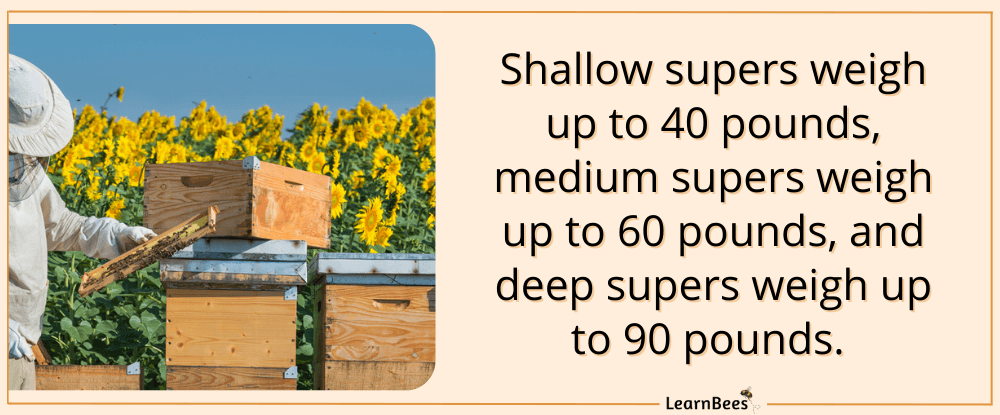
Strong beekeepers may have no trouble lifting deep honey supers. However, medium honey supers are by far the most popular option.
But at the end of the day?
Hive boxes are hive boxes. Honeybees don’t care what size they come in. They’ll store honey in them regardless.
That’s why beekeepers should pick the right size super for their capabilities. Think about what you want long-term. If deep supers, for instance, put too much strain on your back, then you should consider using medium or shallow supers.
Remember:
You want to enjoy the beekeeping hobby – not see it as a chore.
And while lifting 90-pound supers is no big deal for some, it can get exhausting for others. Especially considering many beekeepers have multiple hives they have to do it for.
When Should I Add a Super for My Bees?
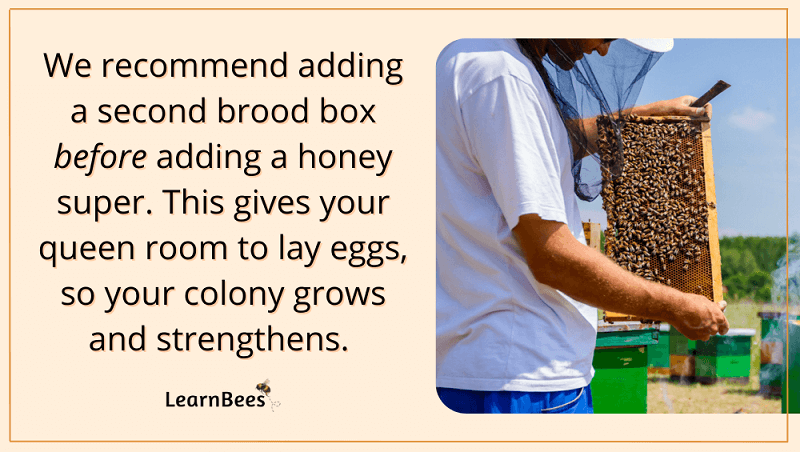
We recommend adding a second brood box before adding a honey super. This gives your queen enough room to lay eggs, thus allowing your colony to grow and strengthen.
In case you forgot:
A brood box is where the queen honeybee lays eggs, and it’s placed on the bottom.
You’ll use just one deep brood box when you first start beekeeping. Once that brood box is 80% full, then you’ll add a second brood box. That way, you let your colony grow into the hive more effectively.
If your bees start with too much space, they can have trouble keeping the hive warm or protecting it against pests like hive beetles.
Once the second brood box is 80% full, then you can place your honey super on top.
Will Adding a Super Prevent Swarming?
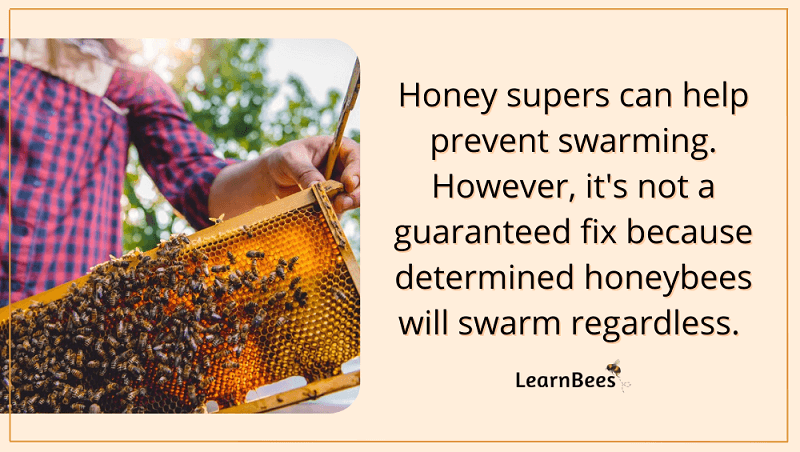
Adding a honey super can help prevent swarming, but it’s not guaranteed to work.
Remember:
If your bees are deadset on swarming, then you can only delay – not stop – them from doing so.
Many people believe that bees swarm when they’re crowded. However, this is not always the case.
In his book Honeybee Democracy, Dr. Thomas Seeley notes, “To this day, no one knows what specific stimuli the worker bees are sensing and integrating when they make the critical decision to start the swarming process.”
Congestion can lead to swarming, yes.
But honeybees are also naturally hardwired to swarm because it’s how they reproduce.
Without swarming, we would have no honeybees.
Still, many beekeepers need to use preventative measures – especially those living in urban environments with neighbors nearby.
There are other methods of swarm prevention, including:
- Using screened bottom boards to provide better ventilation
- Reversing the hive bodies to keep the brood nest lower and give room above the brood nest for honey storage
- Using slatted racks to provide the colony with more space to cluster in the brood nest
- Adding upper entrances to decrease congestion at lower entrances and improve ventilation
- Placing follower boards between the brood box and frames to give the bees more space to cluster
- Cutting burr comb between the frames so the queen can move around more easily
FAQs on Super for Bees
- How do you add supers to a beehive?
- Why are honey supers called supers?
- Is it too late to add honey supers?
- Can I leave a honey super on over winter?
- Can you put too many supers on a hive?
- How many supers should you have per hive?
- How long does it take to clear bees from a super?
- Can you feed bees with supers on?
- How long can I leave honey supers on?
- Can a beehive have only one super?
- Why are my bees not using honey super?
- Will bees move honey from the brood box to the super?
- Should I add a second brood box or super?
- How much honey do you get from a full super?
How do you add supers to a beehive? Where do you put a honey super?
Honey supers are placed on top of the brood boxes. Additionally, some beekeepers use queen excluders between the brood box and the honey supers to prevent the queen from laying eggs in the honey supers.
—> Go back to the FAQs on super for bees
More to Explore:
Why are honey supers called supers?
Super is short for “superstructure,” which is simply the name that honey supers were given when they were created.
—> Go back to the FAQs on super for bees
More to Explore:
Is it too late to add honey supers?
“Too late” really depends on your local conditions.
For example, I add as needed until the last of the fall asters and goldenrod turns brown, and the bees stop foraging on them. In southern climates, that may be at the end of November. In northern climates, that may be mid to late September.
In a nutshell:
Watching your bees and the flowering plants near you would be best. Keep an eye on the frames to see if the bees are bringing in nectar. It’s all local, and it’s all about observation.
—> Go back to the FAQs on super for bees
More to Explore:
Can I leave a honey super on over winter?
Yes, you can leave honey supers on over the winter – even if they’re not full.
Ultimately, it all depends on what they need to winter in your climate. Colder climates require more honey storage than warmer climates. When in doubt, you can always leave one extra box than is recommended.
Also, you should try to network with local beekeepers who can help you. They understand your local climate and conditions, such as temperature, rainfall, and nectar sources. Never underestimate the power of having a good beekeeping mentor or two.
—> Go back to the FAQs on super for bees
More to Explore:
- How Many Bees Are in a Hive?
- What is Backyard Beekeeping?
- Honey Extractors 101: Everything You Need to Know
Can you put too many supers on a hive?
Yes, you can put too many supers on a hive. Bees don’t do well with too much space. “Too many” is over one that doesn’t get filled. For example, I’ve known beekeepers who stack too many every year and then deal with all those partially filled boxes.
—> Go back to the FAQs on super for bees
More to Explore:
How many supers should you have per hive?
Three supers per hive is ideal in most cases.
—> Go back to the FAQs on super for bees
More to Explore:
- How Many Brood Boxes Should I Start With?
- How to Identify and Handle Queen Cells
- What is Festooning?
How long does it take to clear bees from a super?
Usually, no more than 24 hours. Sometimes you may be left with one or two bees.
—> Go back to the FAQs on super for bees
More to Explore:
Can you feed bees with supers on?
You should never feed your honeybees sugar water while you have honey supers on. This can lead to your bees storing sugar syrup instead of actual honey.
So you should stop feeding your bees sugar water well before putting your honey supers on. Feeding can be stopped once nectar is consistently available in your area. It’s important to keep an eye on what’s blooming in your area and remember that not all flowers produce nectar.
—> Go back to the FAQs on super for bees
How long can I leave honey supers on? When should honey supers be removed?
You can leave a honey super or several on the hive over the winter. Many beekeepers do leave a super or two for the bees.
However, leaving too much space in the hive during the cold months can be risky. Especially during late fall and early spring, when colony sizes are low – and the bees may not be able to protect all that comb.
Therefore, removing any boxes beyond what the bees need to survive the winter is smart. This should leave the bees with plenty of space but not too much territory to protect.
With that said:
Picking the right time to remove honey supers for winter depends on where you live. There is no exact calendar date that acts as a “one size fits all.”
Some regions have cold temperatures much sooner than others. Plus, it also depends on your local nectar sources. You should pay attention to blooming flowers and temperature changes.
For example, if you live in an area with a long, mild autumn that offers the bees plenty of nectar-abundant flowers, you may keep your supers on a bit longer. However, it’ll be time to remove those honey supers before any true cold weather hits.
—> Go back to the FAQs on super for bees
Can a beehive have only one super?
Yes, in fact, it’s best only to add one box at a time. When your second brood box is 70-80% full, you should add your honey super.
—> Go back to the FAQs on super for bees
Why are my bees not using honey super?
Bees aren’t using the honey super because they’re not ready. Your bees will start filling the honey super once your brood box is full.
If the whole summer comes and goes, and they never put anything in the supers, it’s because there wasn’t a nectar surplus. The amount of honey your bees store depends on how much nectar is available.
—> Go back to the FAQs on super for bees
Will bees move honey from the brood box to the super?
Yes, bees will move the honey “upstairs” to the super if they need more room in the brood box for eggs.
—> Go back to the FAQs on super for bees
Should I add a second brood box or super?
We recommend adding a second brood box first. By giving the bees more room in the brood nest, you’ll encourage them to lay more eggs.
Once the colony has outgrown the second brood box, you can add a super. Remember that it may take patience for your colony to become established. Most new beekeepers don’t harvest honey during their first year because their hives aren’t established yet.
—> Go back to the FAQs on super for bees
How much honey do you get from a full super?
It depends on your super size and how many frames are in them. Shallow honey supers typically hold about 30-40 pounds of honey, while deep supers can hold 70-90 pounds. The happy medium – aka medium supers – are the most popular and hold about 60 pounds of honey.
The size you choose will depend largely on your physical strength. Generally, it’s best to start with shallows or mediums, so you don’t get overwhelmed. Those deep supers can be extremely heavy, especially if you have multiple hives.
The last thing you want to do is throw your back out trying to lift heavy beekeeping equipment.
